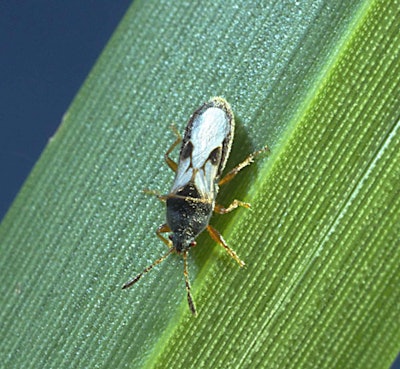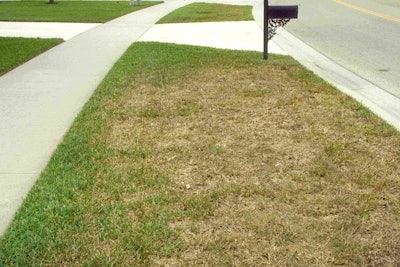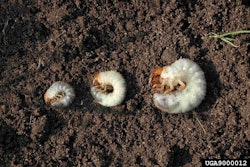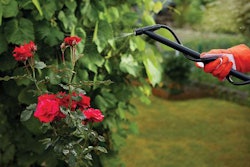 Southern chinch bug on blade of St. Augustine
Southern chinch bug on blade of St. AugustinePhoto: David Shetlar, The Ohio State University, Bugwood.org
Give a chinch an inch, and they’ll take a yard. This old southern saying about chinch bugs speaks to the destructive nature of these pests that threaten turf in the South and Southeast.
Even though chinch bugs are found throughout the United States, it’s the southern chinch bug that has notoriously evaded control by developing resistance to some of the most commonly used insecticides.
However, a ton of products are available to rid this pest from commercial turf and residential lawns. If you’re not getting the results from the product you’re using and you live in Florida, there’s a chance that chinch bugs have become resistant to it. Most likely, though, you simply need to evaluate and adjust your method of application.
Doing damage
Experts consistently describe the cost of controlling the southern chinch bug in the millions. In Florida alone, $5 million annually is spent on control and on replacing chinch-damaged turf. Richard Duble, professor and extension turfgrass specialist at Texas A&M University, calls the southern chinch bug the most destructive pest of St. Augustine grass lawns, with more than $50 million spent each year for its control.
 Typical damage to home lawn
Typical damage to home lawnPhoto: David Shetlar, The Ohio State University, Bugwood.org
Southern chinch bugs are active most of the year. In especially warmer regions, like south Florida, they can be active all year long, feeding on St. Augustine grass. With overlapping life stages, they are nearly constantly a threat.
Populations tend to clump together to feed in one area before moving on to the next, draining the sap from turf until it withers. “As their host plants die, individuals will walk to neighboring St. Augustine grass plant to continue feeding,” says Eileen Buss, associate professor of entomology at the University of Florida. “Thus, dead patches of grass seem to get larger over time.”
Checking for chinch bugs
Confirming a chinch bug population in turf is easier said than done, as chinch bug damage can be confused with that of other insect pests and some diseases, as well as dehydration. Damage in St. Augustine first presents itself as yellow or brownish spots.
“Damage may occur in open, sunny areas near sidewalks and driveways but also in the middle of lawns,” Buss says. “Infested plants have slower growth, turn yellow, then rusty reddish-brown and die. The damage is often confused with drought or frost stress.”
To confirm the cause, look for chinch bugs between the thatch and soil of a yellowed area. Adults are 1/5-inch long and have black bodies and white wings. Buss says another option is to use a Dust Buster or handheld vacuum to suck up any bugs near damaged areas. Empty the contents to find nymphs or adult chinch bugs.
Hard to resist
Outside of Florida, chinch bug resistance to insecticides isn’t all that common. So if you are using a product labeled to control them and it isn’t doing the job, resistance should not be your first consideration.
“It is important to understand that other than a few populations in Florida, most populations in other states are not known to be resistant to some of the most commonly used insecticides, such as bifenthrin (Talstar and others),” says Juang Horng Chong, assistant professor of entomology at Clemson University. “I would not assume resistance is the main factor when there is a difficult-to-control population outside of Florida.”
Instead, Chong recommends considering how you’re applying the product. In fact, he says most of the issues related to poor control of southern chinch bugs stems from poor application and penetration.
“It is important to use either high-volume spray (2-5 gallons per 1,000 square feet) or watering-in after application to drive the insecticides down to the thatch layer where the chinch bugs are feeding and hiding,” Chong says. “Dethatching before the application also helps. Following good preparation and application precautions, even an often-used insecticide, such as bifenthrin, can be effective.”
If you’re working on a lawn that has been treated with a single insecticidal active ingredient during multiple years and aren’t getting results — and are confident in your application method — Chong recommends contacting your state extension personnel for help in determining if resistance is indeed an issue.
Fighting the resistance
 Adult and nymph feeding on St. Augustine
Adult and nymph feeding on St. AugustinePhoto: David Shetlar, The Ohio State University, Bugwood.org
“If resistance is indeed an issue, then the use of all the insecticides belonging to the affected chemical class or mode of action must be stopped,” says Chong. “To delay resistance development and to develop a program after the resistance is confirmed, insecticides of different modes of action should be used.”
The Insecticide Resistance Action Committee (IRAC) has developed a coding system to make the determination of the mode of action easy for everyone. Many insecticide manufacturers have adopted this code and include it prominently on their chemical label (usually above or close to the brand name of the product), Chong explains.
Within this system, each mode of action is assigned a number. To rotate modes of action, you would rotate products that have different numbers.
“It is important to remember that insecticides of different brand names may have the same IRAC number and that insecticides belonging to IRAC number 1A (Carbamates) are of the same mode of action as 1B (Organophosphates) and should not be rotated in sequence. A typical rotation program would rotate insecticides of different modes of action (or IRAC numbers) for different generations of the target pest,” Chong says. “For chinch bugs, that means using products of a single mode of action for about 2 months (1 1/2 months in Florida in the summer) then changing to products of another mode of action.”
Unless the population is especially large and damaging, a few treatments at 14 days apart should do well in preventing damage, he says.
While there are a lot of insecticides registered for management of chinch bugs, Chong recommends carbamates (1A), organophosphates (1B) and pyrethroids (3).
“In my experience, most of the systemic neonicotinoids (4A) are for suppression at best, except for clothianidin (Arena, Aloft), which has good efficacy and is quickly becoming a good choice for managing the pyrethroid-resistant population in Florida,” Chong says. “Chlorantraniliprole (Acelepryn) is also labeled for suppression of chinch bugs and must reapplied ahead of the population build up.”









